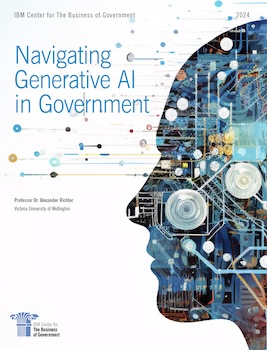
Implementing Generative AI in Government: Challenges and Opportunities

Generative AI refers to algorithms that can create realistic content such as images, text, music, and videos by learning from existing data patterns. Generative AI does more than just create content, it also serves as a user-friendly interface for other AI tools, making complex results easy to understand and use. Generative AI transforms analysis and prediction results into personalized formats, improving explainability by converting complicated data into understandable content. As Generative AI evolves, it plays an active role in collaborative processes, functioning as a vital collaborator by offering strengths that complement human abilities.
Generative AI has the potential to revolutionize government agencies by enhancing efficiency, improving decision making, and delivering better services to citizens, while maintaining agility and scalability. However, in order to implement generative AI solutions effectively, government agencies must address key implementation challenges, which can include introducing risks around data privacy, legal liabilities, and ethical concerns; governments should identify what problems AI can solve, build data governance frameworks, and develop scaling strategies to ensure a thoughtful and effective AI strategy. By exploring use cases, agencies can better understand the transformative potential of generative AI and align it with their unique needs and ethical considerations.
A new report from the IBM Center, Navigating Generative AI in Government by Professor Dr. Alexander Richter, with the Wellington School of Business and Government at Victoria University, distills perspectives from two expert roundtable of leaders in Australia, to present a set of strategic pathways for integrating generative AI in government. These discussions provided valuable perspectives that shaped the nine key themes for effectively integrating generative AI in government:
- Digital Transformation: Generative AI supports digital transformation by optimizing workflows and resources, driving efficiency while encouraging innovation and learning— rather than focusing solely on new technology adoption.
- Use Cases and ROI: Demonstrating tangible returns on investment through use cases such as automated IT support can justify AI investments and guide future strategies.
- Data Foundation: High-quality data management is critical for effective AI outcomes, necessitating robust data governance and infrastructure.
- Ethical Considerations: Ensuring fairness, transparency, and accountability in AI practices is vital for maintaining public trust and avoiding biases.
- Balancing Experimentation with Risk Management: Government agencies must balance the need for innovation with robust risk management, updating policies to allow safe experimentation while protecting against real risks.
- Shifting the Cultural Mindset: Overcoming risk aversion is key to AI adoption. Leadership should foster a culture that encourages safe experimentation and views failure as a learning opportunity.
- Skills Development: Continuous education and training programs are essential to equip the workforce with the necessary expertise to implement and manage AI technologies.
- Diversity of AI Tools: Leveraging a variety of AI tools tailored to specific government needs ensures effective and secure deployments.
- Human-AI Collaboration: Designing flexible AI systems that complement human roles enhances collaboration and decision making.
As the report concludes, developing adaptive governance models, investing in robust data infrastructure, promoting a culture of innovation, and implementing comprehensive training programs are critical steps. Additionally, expanding AI-driven citizen services and enhancing public engagement and transparency will build trust and ensure that AI initiatives align with public service values and goals, while maintaining accountability and trust.



